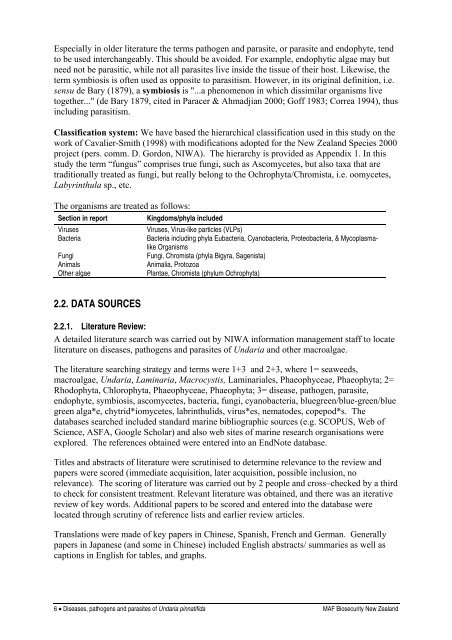Diseases, pathogens and parasites of Undaria pinnatifida
Diseases, pathogens and parasites of Undaria pinnatifida
Diseases, pathogens and parasites of Undaria pinnatifida
Create successful ePaper yourself
Turn your PDF publications into a flip-book with our unique Google optimized e-Paper software.
Especially in older literature the terms pathogen <strong>and</strong> parasite, or parasite <strong>and</strong> endophyte, tend<br />
to be used interchangeably. This should be avoided. For example, endophytic algae may but<br />
need not be parasitic, while not all <strong>parasites</strong> live inside the tissue <strong>of</strong> their host. Likewise, the<br />
term symbiosis is <strong>of</strong>ten used as opposite to parasitism. However, in its original definition, i.e.<br />
sensu de Bary (1879), a symbiosis is "...a phenomenon in which dissimilar organisms live<br />
together..." (de Bary 1879, cited in Paracer & Ahmadjian 2000; G<strong>of</strong>f 1983; Correa 1994), thus<br />
including parasitism.<br />
Classification system: We have based the hierarchical classification used in this study on the<br />
work <strong>of</strong> Cavalier-Smith (1998) with modifications adopted for the New Zeal<strong>and</strong> Species 2000<br />
project (pers. comm. D. Gordon, NIWA). The hierarchy is provided as Appendix 1. In this<br />
study the term “fungus” comprises true fungi, such as Ascomycetes, but also taxa that are<br />
traditionally treated as fungi, but really belong to the Ochrophyta/Chromista, i.e. oomycetes,<br />
Labyrinthula sp., etc.<br />
The organisms are treated as follows:<br />
Section in report Kingdoms/phyla included<br />
Viruses Viruses, Virus-like particles (VLPs)<br />
Bacteria Bacteria including phyla Eubacteria, Cyanobacteria, Proteobacteria, & Mycoplasmalike<br />
Organisms<br />
Fungi Fungi, Chromista (phyla Bigyra, Sagenista)<br />
Animals Animalia, Protozoa<br />
Other algae Plantae, Chromista (phylum Ochrophyta)<br />
2.2. DATA SOURCES<br />
2.2.1. Literature Review:<br />
A detailed literature search was carried out by NIWA information management staff to locate<br />
literature on diseases, <strong>pathogens</strong> <strong>and</strong> <strong>parasites</strong> <strong>of</strong> <strong>Undaria</strong> <strong>and</strong> other macroalgae.<br />
The literature searching strategy <strong>and</strong> terms were 1+3 <strong>and</strong> 2+3, where 1= seaweeds,<br />
macroalgae, <strong>Undaria</strong>, Laminaria, Macrocystis, Laminariales, Phaeophyceae, Phaeophyta; 2=<br />
Rhodophyta, Chlorophyta, Phaeophyceae, Phaeophyta; 3= disease, pathogen, parasite,<br />
endophyte, symbiosis, ascomycetes, bacteria, fungi, cyanobacteria, bluegreen/blue-green/blue<br />
green alga*e, chytrid*iomycetes, labrinthulids, virus*es, nematodes, copepod*s. The<br />
databases searched included st<strong>and</strong>ard marine bibliographic sources (e.g. SCOPUS, Web <strong>of</strong><br />
Science, ASFA, Google Scholar) <strong>and</strong> also web sites <strong>of</strong> marine research organisations were<br />
explored. The references obtained were entered into an EndNote database.<br />
Titles <strong>and</strong> abstracts <strong>of</strong> literature were scrutinised to determine relevance to the review <strong>and</strong><br />
papers were scored (immediate acquisition, later acquisition, possible inclusion, no<br />
relevance). The scoring <strong>of</strong> literature was carried out by 2 people <strong>and</strong> cross–checked by a third<br />
to check for consistent treatment. Relevant literature was obtained, <strong>and</strong> there was an iterative<br />
review <strong>of</strong> key words. Additional papers to be scored <strong>and</strong> entered into the database were<br />
located through scrutiny <strong>of</strong> reference lists <strong>and</strong> earlier review articles.<br />
Translations were made <strong>of</strong> key papers in Chinese, Spanish, French <strong>and</strong> German. Generally<br />
papers in Japanese (<strong>and</strong> some in Chinese) included English abstracts/ summaries as well as<br />
captions in English for tables, <strong>and</strong> graphs.<br />
6 • <strong>Diseases</strong>, <strong>pathogens</strong> <strong>and</strong> <strong>parasites</strong> <strong>of</strong> <strong>Undaria</strong> <strong>pinnatifida</strong> MAF Biosecurity New Zeal<strong>and</strong>

















